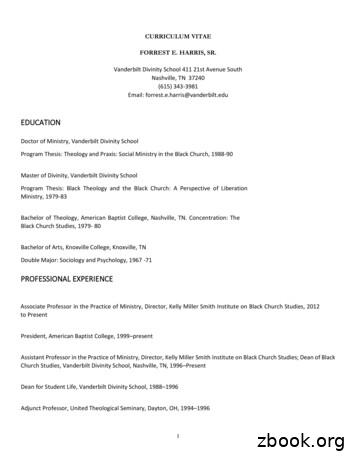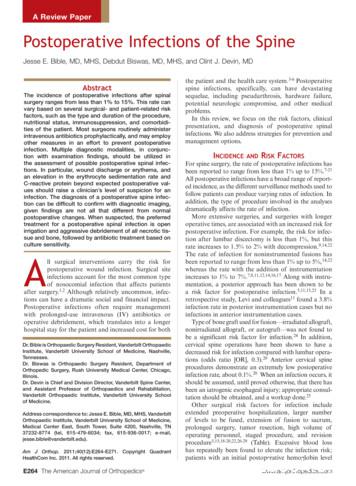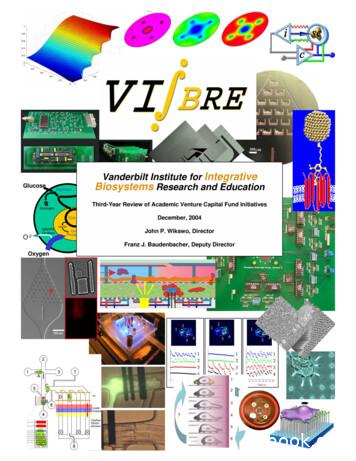Controlled Chemicals - Vanderbilt University
Controlled ChemicalsThe Bureau of Industry and Security of the U.S. Department of Commerce may require a license toexport the following chemicals listed in Category 1 (one) of the Export Administration Regulations(EAR). For details regarding regulations, please review the Chemical Weapons Convention (CWC)provisions of the EAR at http://www.cwc.gov/regulations ear provisions.htmlSections of Category 1modified for the CWC(Scroll to theapplicable ECCN):1C350Chemicals That May Be Used as Precursors for Toxic Chemical Agents1C351Human and Zoonotic Pathogens and “Toxins”1C355Chemical Weapons Convention (CWC) Schedule 2 and 3 Chemicals andFamilies of Chemicals Not Controlled by ECCN 1C350 or by TheDepartment of State Under the ITAR1C395Mixtures and Medical, Analytical, Diagnostic, and Food Testing Kits NotControlled by ECCN 1C3501C991*Vaccines, Immunotoxins, Medical Products, Diagnostic and Food TestingKits1C995*Mixtures not controlled by ECCN 1C350, ECCN 1C355 or ECCN 1C395that contain chemicals controlled by ECCN 1C350 or ECCN 1C355 andmedical, analytical, diagnostic, and food testing kits not controlled byECCN 1C350 or ECCN 1C395 that contain chemicals controlled by ECCN1C350.d, as follows (see List of Items controlled).1E001*“Technology” According to the General Technology Note for the“Development” or “Production” of Items Controlled by 1A001.b,1A001.c, 1A002, 1A003, 1A004, 1A005, 1A101, 1B, or 1C (except 1C355,1C980 to 1C984, 1C988, 1C990, 1C991, 1C992, and 1C995)1E355Technology for the Production of Chemical Weapons Convention (CWC)Schedule 2 and 3 Chemicals*ECCN is not subject to CWC control (CW reason for control), but is a related controlA license is required to export the following chemicals listed in the U.S. Department of State, Directorateof Defense Trade Controls (DDTC), Consolidated International Traffic in Arms Regulations (ITAR) Title22, Code of Federal Regulations, Chapter I, Part 121. For details regarding regulations, please review theChemical Weapons Convention (CWC) provisions of the U.S. State Department regulation athttp://www.cwc.gov/regulations state.html :Last revision Feb 2013
Controlled ChemicalsCATEGORY XIV—TOXICOLOGICAL AGENTS, INCLUDING CHEMICAL AGENTS, BIOLOGICAL AGENTS, ANDASSOCIATED EQUIPMENT* (a) Chemical agents, to include:(1) Nerve agents:(i) O-Alkyl (equal to or less than C10, including cycloalkyl) alkyl (Methyl, Ethyl, nPropyl or Isopropyl)phosphonofluoridates, such as: Sarin (GB): O-Isopropylmethylphosphonofluoridate (CAS 107–44–8) (CWC Schedule 1A); and Soman (GD):OPinacolyl methylphosphonofluoridate (CAS 96–64–0) (CWC Schedule 1A);(ii) O-Alkyl (equal to or less than C10, including cycloalkyl) N,N-dialkyl (Methyl, Ethyl, nPropyl or Isopropyl) phosphoramidocyanidates, such as: Tabun (GA): O-Ethyl N,Ndimethylphosphoramidocyanidate (CAS 77– 81–6) (CWC Schedule 1A);(iii) O-Alkyl (H or equal to or less than C10, including cycloalkyl) S–2-dialkyl (Methyl,Ethyl, n-Propyl or Isopropyl)aminoethyl alkyl (Methyl, Ethyl, n-Propyl or Isopropyl)phosphonothiolates and corresponding alkylated and protonated salts, such as: VX: OEthyl S-2- diisopropylaminoethyl methyl phosphonothiolate (CAS 50782–69–9) (CWCSchedule 1A);(2) Amiton: O,O-Diethyl S- [2(diethylamino)ethyl] phosphorothiolate and correspondingalkylated or protonated salts (CAS 78–53–5) (CWC Schedule 2A);(3) Vesicant agents:(i) Sulfur mustards, such as: 2- Chloroethylchloromethylsulfide (CAS 2625– 76–5) (CWCSchedule 1A); Bis(2- chloroethyl)sulfide (CAS 505–60–2) (CWC Schedule 1A); Bis(2hloroethylthio)methane (CAS 63839–13–6) (CWC Schedule 1A); 1,2-bis (2chloroethylthio)ethane (CAS 3563–36–8) (CWC Schedule 1A); 1,3-bis (2chloroethylthio)-n-propane (CAS 63905–10–2) (CWC Schedule 1A); 1,4-bis (2chloroethylthio)-n-butane (CWC Schedule 1A); 1,5-bis (2-chloroethylthio)-n-pentane(CWC Schedule 1A); Bis (2- chloroethylthiomethyl)ether (CWC Schedule 1A); Bis (2chloroethylthioethyl)ether (CAS 63918–89–8) (CWC Schedule 1A);(ii) Lewisites, such as: 2- chlorovinyldichloroarsine (CAS 541–25–3) (CWC Schedule 1A);Tris (2-chlorovinyl) arsine (CAS 40334–70–1) (CWC Schedule 1A); Bis (2-chlorovinyl)chloroarsine (CAS 40334–69–8) (CWC Schedule 1A);(iii) Nitrogen mustards, such as: HN1: bis (2-chloroethyl) ethylamine (CAS 538–07–8)(CWC Schedule 1A); HN2: bis (2-chloroethyl) methylamine (CAS 51–75–2) (CWCSchedule 1A); HN3: tris (2-chloroethyl)amine (CAS 555– 77–1) (CWC Schedule 1A);(iv) Ethyldichloroarsine (ED);(v) Methyldichloroarsine (MD);(4) Incapacitating agents, such as:(i) 3-Quinuclindinyl benzilate (BZ) (CAS 6581–06–2) (CWC Schedule 2A);(ii) Diphenylchloroarsine (DA) (CAS 712–48– 1);(iii) Diphenylcyanoarsine (DC);* (b) Biological agents and biologically derived substances specifically developed, configured, adapted,or modified for the purpose of increasing their capability to produce casualties in humans or livestock,degrade equipment or damage crops.Last revision Feb 2013
Controlled Chemicals* (c) Chemical agent binary precursors and key precursors, as follows:(1) Alkyl (Methyl, Ethyl, n-Propyl or Isopropyl) phosphonyl difluorides, such as: DF:Methyl Phosphonyldifluoride (CAS 676–99–3) (CWC Schedule 1B); Methylphosphinyldifluoride;(2) O-Alkyl (H or equal to or less than C10, including cycloalkyl) O–2-dialkyl (methyl, ethyl, nPropyl or isopropyl)aminoethyl alkyl (methyl, ethyl, N-propyl or isopropyl) phosphonite andcorresponding alkylated and protonated salts, such as: QL: O-Ethyl-2-di-isopropylaminoethylmethylphosphonite (CAS 57856–11–8) (CWC Schedule 1B);(3) Chlorosarin: O-Isopropyl methylphosphonochloridate (CAS 1445–76–7) (CWC Schedule 1B);(4) Chlorosoman: O-Pinakolyl methylphosphonochloridate (CAS 7040–57–5) (CWC Schedule 1B);(5) DC: Methlyphosphonyl dichloride (CAS 676–97–1) (CWC Schedule 2B);Methylphosphinyldichloride;(d) Tear gases and riot control agents including:(1) Adamsite (Diphenylamine chloroarsine or DM) (CAS 578–94–9);(2) CA (Bromobenzyl cyanide) (CAS 5798–79– 8);(3) CN (Phenylacyl chloride or w- Chloroacetophenone) (CAS 532–27-4);(4) CR (Dibenz-(b,f)-1,4-oxazephine) (CAS 257–07–8);(5) CS (o-Chlorobenzylidenemalononitrile or o-Chlorobenzalmalononitrile) (CAS 2698– 41–1);(6) Dibromodimethyl ether (CAS 4497–29–4);(7) Dichlorodimethyl ether (ClCi) (CAS 542– 88–1);(8) Ethyldibromoarsine (CAS 683–43–2);(9) Bromo acetone;(10) Bromo methylethylketone;(11) Iodo acetone;(12) Phenylcarbylamine chloride;(13) Ethyl iodoacetate;(e) Defoliants, as follows:(1) Agent Orange (2,4,5– Trichlorophenoxyacetic acid mixed with 2,4dichlorophenoxyacetic acid);(2) LNF (Butyl 2-chloro-4- fluorophenoxyacetate)* (f) Equipment and its components, parts, accessories, and attachments specifically designed ormodified for military operations and compatibility with military equipment as follows:(1) The dissemination, dispersion or testing of the chemical agents, biological agents,tear gases and riot control agents, and defoliants listed in paragraphs (a), (b), (d), and (e),respectively, of this category;(2) The detection, identification, warning or monitoring of the chemical agents and biologicalagents listed in paragraph (a) and (b) of this category;(3) Sample collection and processing of the chemical agents and biological agents listed inparagraph (a) and (b) of this category;(4) Individual protection against the chemical and biological agents listed in paragraphs (a) and(b) of this category.(5) Collective protection against the chemical agents and biological agents listed in paragraph (a)and (b) of this category.(6) Decontamination or remediation of the chemical agents and biological agents listed inparagraph (a) and (b) of this category.Last revision Feb 2013
Controlled Chemicals(g) Antibodies, polynucleoides, biopolymers or biocatalysts specifically designed or modified for use witharticles controlled in paragraph (f) of this category.(h) Medical countermeasures, to include pre- and post-treatments, vaccines, antidotes and medicaldiagnostics, specifically designed or modified for use with the chemical agents listed in paragraph (a) ofthis category and vaccines with the sole purpose of protecting against biological agents identified inparagraph (b) of this category. Examples include: barrier creams specifically designed to be applied toskin and personal equipment to protect against vesicant agents controlled in paragraph (a) of thiscategory; atropine auto injectors specifically designed to counter nerve agent poisoning.(i) Modeling or simulation tools specifically designed or modified for chemical or biological weaponsdesign, development or employment. The concept of modeling and simulation includes softwarecovered by paragraph (m) of this category specifically designed to reveal susceptibility or vulnerabilityto biological agents or materials listed in paragraph (b) of this category.(j) Test facilities specifically designed or modified for the certification and qualification of articlescontrolled in paragraph (f) of this category.(k) Equipment, components, parts, accessories, and attachments, exclusive of incinerators (includingthose which have specially designed waste supply systems and special handling facilities), specificallydesigned or modified for destruction of the chemical agents in paragraph (a) or the biological agents inparagraph (b) of this category. This destruction equipment includes facilities specifically designed ormodified for destruction operations.(l) Tooling and equipment specifically designed or modified for the production of articles controlled byparagraph (f) of this category.(m) Technical data (as defined in § 120.10 of this subchapter) and defense services (as defined in § 120.9of this subchapter) related to the defense articles enumerated in paragraphs (a) through (l) of thiscategory. (See § 125.4 of this subchapter for exemptions.) Technical data directly related to themanufacture or production of any defense articles enumerated elsewhere in this Category that aredesignated as Significant Military Equipment (SME) shall itself be designated as SME.(n) The following interpretations explain and amplify the terms used in this category and elsewhere inthis subchapter.(1) A chemical agent in category XIV(a) is a substance having military application, which by itsordinary and direct chemical action, produces a powerful physiological effect.(2) The biological agents or biologically derived substances in paragraph (b) of this categoryare those agents and substances capable of producing casualties in humans or livestock,degrading equipment or damaging crops and which have been modified for the specific purposeof increasing such effects. Examples of such modifications include increasing resistance to UVradiation or improving dissemination characteristics. This does not include modifications madeonly for civil applications (e.g., medical or environmental use).(3) The destruction equipment controlled by this category related to biological agents inparagraph (b) is that equipment specifically designed to destroy only the agents identified inparagraph (b) of this category.Last revision Feb 2013
Controlled Chemicals(4)(i) The individual protection against the chemical and biological agents controlled by thiscategory includes military protective clothing and masks, but not those items designed fordomestic preparedness (e.g., civil defense). Domestic preparedness devices for individualprotection that integrate components and parts identified in this subparagraph are licensed bythe Department of Commerce when such components are:(A) Integral to the device;(B) inseparable from the device; and,(C) incapable of replacement without compromising the effectiveness of the device.(ii) Components and parts identified in this subparagraph exported for integration into domesticpreparedness devices for individual protection are subject to the controls of the ITAR;(5) Technical data and defense services in paragraph (l) include libraries, databases andalgorithms specifically designed or modified for use with articles controlled in paragraph (f) ofthis category.(6) The tooling and equipment covered by paragraph (l) of this category includes molds used toproduce protective masks, overboots, and gloves controlled by paragraph (f) and leak detectionequipment specifically designed to test filters controlled by paragraph(f) of this category.(7) The resulting product of the combination of any controlled or non-controlled substancecompounded or mixed with any item controlled by this subchapter is also subject to the controlsof this category.NOTE 1: This Category does not control formulations containing 1% or less CN or CS or individuallypackaged tear gases or riot control agents for personal self-defense purposes.NOTE 2: Categories XIV(a) and (d) do not include the following:(1) Cyanogen chloride;(2) Hydrocyanic acid;(3) Chlorine;(4) Carbonyl chloride (Phosgene);(5) Ethyl bromoacetate;(6) Xylyl bromide;(7) Benzyl bromide;(8) Benzyl iodide;(9) Chloro acetone;(10) Chloropicrin (trichloronitromethane);(11) Fluorine;(12) Liquid pepper.NOTE 3: Chemical Abstract Service (CAS) registry numbers do not cover all the substances and mixturescontrolled by this category. The numbers are provided as examples to assist the government agencies inthe license review process and the exporter when completing their license application and exportdocumentation.NOTE 4: With respect to U.S. obligations under the Chemical Weapons Convention (CWC), refer toChemical Weapons Convention Regulations (CWCR) (15 CFR parts 710 through 722). As appropriate, theCWC schedule is provided to assist the exporter.NOTE 5: Pharmacological formulations containing nitrogen mustards and certain reference standards forthese drugs are not considered to be chemical agents and are licensed by the Department of CommerceLast revision Feb 2013
Controlled Chemicalswhen:(1) The drug is in the form of a final medical product; or(2) The reference standard contains salts of HN2 [bis(2-chloroethyl) methylamine], the quantityto be shipped is 150 milligrams or less, and individual shipments do not exceed twelve percalendar year per end user.Technical data for the production of HN1 [bis(2-chloroethyl)ethylamine]; HN2 [bis(2chloroethyl)methylamine], HN3 [tris(2- chloroethyl)amine]; or salts of these, such as tris (2chloroethyl)amine hydrochloride, remains controlled under this Category.The Bureau of Industry and Security of the U.S. Department of Commerce requires adherence to specificregulations regarding the following chemicals. For details, please visit the Chemical WeaponsConvention website at http://www.cwc.gov/regulations cwc.html :Schedule 1 chemicals:A. Toxic chemicals:(CAS registry number)(1) 0-Alkyl ( C10, incl. cycloalkyl) alkyl(Me, Et, n-Pr or i-Pr)-phosphonofluoridatese.g. Sarin: 0-Isopropyl methylphosphonofluoridateSoman: 0-Pinacolyl methylphosphonofluoridate(107-44-8)(96-64-0)(2) 0-Alkyl ( C10, incl. cycloalkyl) N,N-dialkyl(Me, Et, n-Pr or i-Pr)-phosphoramidocyanidatese.g. Tabun: 0-Ethyl N,N-dimethylphosphoramidocyanidate(77-81-6)(3) 0-Alkyl (H or C10, incl. cycloalkyl) S-2dialkyl(Me, Et, n-Pr or i-Pr)-aminoethyl alkyl(Me, Et, n-Pr or i-Pr)-phosphonothiolates andcorrespondingalkylated or protonated saltse.g. VX: 0-Ethyl S-2-diisopropylaminoethylmethyl phosphonothiolate(50782-69-9)(4) Sulfur mustards:2-ChloroethylchloromethylsulfideMustard gas: haneSesquimustard: oethylthiomethyl)ether0-Mustard: Bis(2-chloroethylthioethyl)etherLast revision Feb 3918-89-8)
Controlled Chemicals(5) Lewisites:Lewisite 1: 2-ChlorovinyldichloroarsineLewisite 2: Bis(2-chlorovinyl)chloroarsineLewisite 3: 334-70-1)(6) Nitrogen mustards:HN1: Bis(2-chloroethyl)ethylamineHN2: Bis(2-chloroethyl)methylamineHN3: Tris(2-chloroethyl)amine(7) Saxitoxin(8) RicinB. 8)(9009-86-3)(CAS registry number)(9) Alkyl (Me, Et, n-Pr ori-Pr)phosphonyldifluoridese.g. DF:Methylphosphonyldifluoride(676-99-3)(10) 0-Alkyl (H or C10,incl. cycloalkyl) 0-2dialkyl(Me, Et, n-Pr or i-Pr)aminoethyl alkyl(Me, Et, n-Pr or i-Pr)phosphonites andcorrespondingalkylated or protonatedsaltse.g. QL: 0-Ethyl -8)(11) Chlorosarin: 0Isopropylmethylphosphonochloridate(1445-76-7)(12) Chlorosoman: 0Pinacolylmethylphosphonochloridate(7040-57-5)Last revision Feb 2013
Controlled ChemicalsNotes to Supplement No. 1:Note 1: Note that the following Schedule 1 chemicals are controlled for export purposes under the ExportAdministration Regulations (see part 774 of the EAR, the Commerce Control List): 0-Ethyl-2diisopropylaminoethyl methylphosphonite (QL) (C.A.S. #57856-11-8), Ethylphosphonyl difluoride (C.A.S.#753-98-0), Methylphosphonyl difluoride (C.A.S. #676-99-3), Saxitoxin (35523-89-8), Ricin (9009-86-3).Note 2: All Schedule 1 chemicals not listed in Note 1 to this Supplement are controlled for export purposes bythe Office of Defense Trade Control of the Department of State under the International Traffic in ArmsRegulations (22 CFR parts 120 through 130).Schedule 2 Chemicals:A. Toxic chemicals:(1) Amiton: 0,0-Diethyl S-[2-(diethylamino)ethyl]phosphorothiolate and corresponding alkylated orprotonated salts(2) PFIB: (3) BZ: 3-Quinuclidinyl benzilate (*)B. Precursors:(CAS registry number)(78-53-5)(382-21-8)(6581-06-2)(CAS registry number)(4) Chemicals, except for those listed inSchedule 1, containing a phosphorus atom towhich is bonded one methyl, ethyl or propyl(normal or iso) group but not further carbonatoms,e.g. Methylphosphonyl dichlorideDimethyl methylphosphonateExemption: Fonofos: 0-Ethyl -79-6)(944-22-9)(5) N,N-Dialkyl (Me, Et, n-Pr or i-Pr)phosphoramidic dihalides-(6) Dialkyl (Me, Et, n-Pr or i-Pr) N,N-dialkyl(Me, Et, n-Pr or i-Pr)-phosphoramidates-Last revision Feb 2013
Controlled Chemicals(7) Arsenic trichloride(8) 2,2-Diphenyl-2-hydroxyacetic acid(9) 0) N,N-Dialkyl (Me, Et, n-Pr or i-Pr)aminoethyl-2-chlorides and correspondingprotonated salts-(11) N,N-Dialkyl (Me, Et, n-Pr or i-Pr)aminoethane-2-olsand corresponding protonated salts-Exemptions: N,N-Dimethylaminoethanoland corresponding protonated saltsN,N-Diethylaminoethanoland corresponding protonated salts(108-01-0)(100-37-8)(12) N,N-Dialkyl (Me, Et, n-Pr or i-Pr)aminoethane-2-thiolsand corresponding protonated salts-(13) Thiodiglycol: Bis(2-hydroxyethyl)sulfide(111-48-8)(14) Pinacolyl alcohol: 3,3-Dimethylbutane-2ol(464-07-3)Notes to Supplement No. 1:Note 1: Note that the following Schedule 1 chemicals are controlled for export purposes under the ExportAdministration Regulations (see part 774 of the EAR, the Commerce Control List): 0-Ethyl-2diisopropylaminoethyl methylphosphonite (QL) (C.A.S. #57856-11-8), Ethylphosphonyl difluoride (C.A.S.#753-98-0), Methylphosphonyl difluoride (C.A.S. #676-99-3), Saxitoxin (35523-89-8), Ricin (9009-86-3).Note 2: All Schedule 1 chemicals not listed in Note 1 to this Supplement are controlled for export purposes bythe Office of Defense Trade Control of the Department of State under the International Traffic in ArmsRegulations (22 CFR parts 120 through 130).Schedule 3 Chemicals:A. Toxic chemicals:Last revision Feb 2013(CAS registry number)
Controlled Chemicals(1) Phosgene: Carbonyl dichloride(2) Cyanogen chloride(75-44-5)(506-77-4)(3) Hydrogen cyanide(74-90-8)(4) Chloropicrin: Trichloronitromethane(76-06-2)B. Precursors:(CAS registry number)(5) Phosphorusoxychloride(10025-87-3)(6) Phosphorustrichloride(7719-12-2)(7) Phosphoruspentachloride(10026-13-8)(8) Trimethylphosphite(121-45-9)(9) Triethylphosphite(122-52-1)(10) Dimethylphosphite(868-85-9)(11) Diethylphosphite(762-04-9)(12) Sulfurmonochloride(10025-67-9)(13) Sulfurdichloride(10545-99-0)(14) 139-87-7)(16)Methyldiethanolamine(105-59-9)(17) Triethanolamine(102-71-6)Note to Supplement No. 1: Refer to Supplement No. 1 to part 774 of the Export Administration Regulations(the Commerce Control List), ECCN 1C355, Related Controls for chemicals controlled under the InternationalTraffic in Arms Regulations (22 CFR parts 120 through 130).Last revision Feb 2013
Controlled ChemicalsLast revision Feb 2013
Controlled Chemicals Last revision Feb 2013 CATEGORY XIV—TOXICOLOGICAL AGENTS, INCLUDING CHEMICAL AGENTS, BIOLOGICAL AGENTS, AND ASSOCIATED EQUIPMENT * (a) Chemical agents, to include: (1) Nerve agents: (i) O-Alkyl (equal to or less than C10, including cycloalkyl) alkyl (Methyl, Ethyl, n-
2009 Vanderbilt Football 2009 VANDERBILT FooTBALL VANDERBILT MISSISSIPPI STATE Location Nashville, Tenn. Starkville, Miss. Founded 1873 1878 Enrollment 6,402 17,824 Conference Southeastern Southeastern Nickname Commodores Bulldogs Colors Black & Gold Maroon & White Home Field Vanderbilt Stadium Davis Wade Stadium Capacity 39,773 55,082 Field Surface natural grass natural grass
Vanderbilt Divinity School 411 21st Avenue South Nashville, TN 37240 (615) 343-3981 Email: forrest.e.harris@vanderbilt.edu EDUCATION Doctor of Ministry, Vanderbilt Divinity School Program Thesis: Theology and Praxis: Social Ministry in the Black Church, 1988-90 Master of Divinity, Vanderbilt Divinity School .
Vanderbilt University, Department of Physics and Astronomy, Nashville, TN Associate Professor of Physics (1993-2000) Vanderbilt University, Department of Physics and Astronomy, Nashville, TN Assistant Professor of Physics (1986-1993) Vanderbilt University, Department of Physics and A
loans@vanderbilt.edu Financial Aid Overview. . Vanderbilt University Office of Student Financial Aid 615-322-3591 Anne.bathon@vanderbilt.edu. Title: Financial Aid 101 Author: SNG Created Date: 8/4/2020 2:47:53 PM .
Vanderbilt Orthopaedic Institute, Vanderbilt University School of Medicine. Address correspondence to: Jesse E. Bible, MD, MHS, Vanderbilt Orthopaedic Institute, Vanderbilt University School of Medicine, Medical Center East, South Tower, Suite 4200, Nashville, TN 37232-8774 (tel, 615-479-6034; fax, 615-936-0017; e-mail, .
A number of interlinkages exist between climate change, hazardous chemicals and wastes are identified, including that: Climate change can lead to increased releases of hazardous chemicals into the environment; Chemicals production, chemicals containing products and product usage can give rise to both hazardous chemicals and GHGs;
EXECUTIVE SUMMARY The Vanderbilt Institute for Integrative Biosystems Research and Education, VIIBRE, was created in December, 2001 with a 5.1 million, five-year grant from the Vanderbilt . Venture Capital Fund (AVCF) to help move Vanderbilt University to a leadership role in basic research, technological development, and the delivery of .
VANDERBILT COMMODORES (0-4) STORYLINES Mississippi State hosts Vanderbilt for the 82nd homecoming game in program history. The Bulldogs boast an all-time record of 55-22-3 in homecoming matchups and have won 10 straight. Vanderbilt will be the 39th different homecoming opponent in school history.























